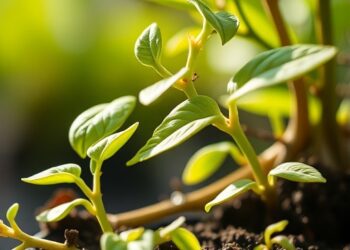In the world of agriculture and horticulture, the importance of fruit coloration and ripeness cannot be overstated. For many species, particularly citrus fruits, the color of the rind serves as a visual cue for consumers, indicating the fruit’s maturity and quality. However, the ripening process is complex and multifaceted. Recent research focused on mandarins from the Chongqing region of China highlights an intriguing inconsistency—while the fruit’s flesh matures, the peel remains stubbornly green. This phenomenon presents significant challenges for growers and marketers alike, adversely affecting the commercial appeal of these fruits.
Mandarins are beloved for their sweetness and ease of peeling, making them a popular choice among consumers. However, when shoppers encounter an unripe green peel, their purchasing decisions can be negatively impacted. The disparity between the inner and outer ripening stages underscores the need for new methods to enhance the visual quality of these fruits before they hit store shelves. The current research published in the Journal of the Science of Food and Agriculture aims to bridge this gap through innovative scientific advancements.
One of the exciting breakthroughs in the study is the application of red and blue LED lights to stimulate coloration in mandarin fruit. This process involves exposing the fruit to specific wavelengths of light that have been established to promote biochemical changes. By using red and blue spectra, researchers noted a substantial enhancement in color development, which could help align the ripening process of the peel with the flesh. As the world increasingly turns to controlled environments for food production, such techniques could revolutionize how fruits are ripened off the tree.
One key aspect of this research entails understanding the biochemical pathways involved in this process. The authors valued the role of chlorophyll, which is primarily responsible for the green color in unripe fruit. The study showed that exposure to these LED lights catalyzes chlorophyll degradation while simultaneously encouraging carotenoid synthesis—the pigments that provide oranges and yellows in fruit coloration. This dual action results in a more aesthetically pleasing product that can compete better in the marketplace.
At the molecular level, a protein designated as CcUNE10 was identified to play a pivotal role in mediating these color changes. Belonging to the bHLH transcription factor family, CcUNE10 is integral to the activation of genes responsible for chlorophyll degradation. Understanding how CcUNE10 functions opens new avenues for genetic engineering efforts aimed at improving fruit qualities. By targeting this transcription factor, breeders might refine their selection processes, leading to cultivars that ripen more uniformly.
Previously, the relationship between gene activation and fruit coloration had been poorly understood, but this study makes significant strides in elucidating such connections. The implication of the bHLH family extends beyond mandarins and indicates a potential universal mechanism applicable to various fruit types. As future research expands on these findings, the agricultural community may gain insights into optimizing coloration in a myriad of horticultural crops.
The implications of this research are not merely theoretical; they hold tangible benefits for growers and consumers alike. With improved ripeness synchronization, producers can expect enhanced sales, improved product quality, and, ultimately, increased profitability. If a larger percentage of mandarin fruit can be sold at optimal prices, it may incentivize farmers to invest more in their production systems, fostering sustainability in the agricultural sector.
Another benefit of using LED light exposure is its sustainability compared to traditional ripening methods. Conventional techniques often involve exposure to ethylene gas, whereas LED lighting offers a cleaner, more energy-efficient alternative. Given the growing emphasis on sustainable practices within the agricultural community, this could represent a significant shift in postharvest handling methods.
Moreover, this cutting-edge study paves the way for further research into postharvest treatments that can enhance the overall quality of a wider range of fruits. The knowledge gained from examining mandarins can be expanded to other crops with similar ripening issues, fueling broader agricultural practices. By understanding the mechanisms underpinning fruit coloration, researchers can tailor solutions to fit various agricultural needs.
Overall, this research showcases the power of interdisciplinary scientific inquiry, connecting agricultural practices with advances in biotechnology and molecular biology. As researchers continue to shed light on the complexities of fruit ripening and coloration, the potential to transform how we grow and market produce becomes clearer. The future of agriculture invariably points to more efficient, sustainable, and market-ready fruit.
In conclusion, the research regarding the effects of red and blue LED light exposure on mandarin fruit represents a pioneering step toward resolving a significant challenge in agricultural production. This study not only elucidates the biochemical pathways involved in color development but also highlights the potential for improved commercial viability for farmers. As we strive for a more sophisticated understanding of agricultural processes and systems, we embrace the possibilities of integrating science with practice in the quest for excellence in food production.
With such breakthroughs, the vision for a future where consumers receive fruits that are not only delicious but also visually appealing becomes increasingly achievable. In a world that is ever more concerned with sustainability, efficiency, and quality, this research exemplifies the kind of innovations needed to advance modern agriculture. The commitment to unraveling the complexities of nature and harnessing that knowledge for practical applications will lead to transformative change in our food systems.
Subject of Research: Effects of LED light on mandarin fruit coloration
Article Title: Functional analysis of the transcription factor CcUNE10 in red and blue LED light irradiation promoted coloration of mandarin fruit
News Publication Date: February 5, 2025
Web References: Journal of the Science of Food and Agriculture
References: DOI: 10.1002/jsfa.14119
Image Credits: Not provided
Keywords: Citrus fruits, mandarin fruit, LED light, chlorophyll degradation, carotenoid synthesis, bHLH transcription factor, postharvest handling, agricultural sustainability, fruit ripening, biotechnology, molecular biology, agricultural research.




